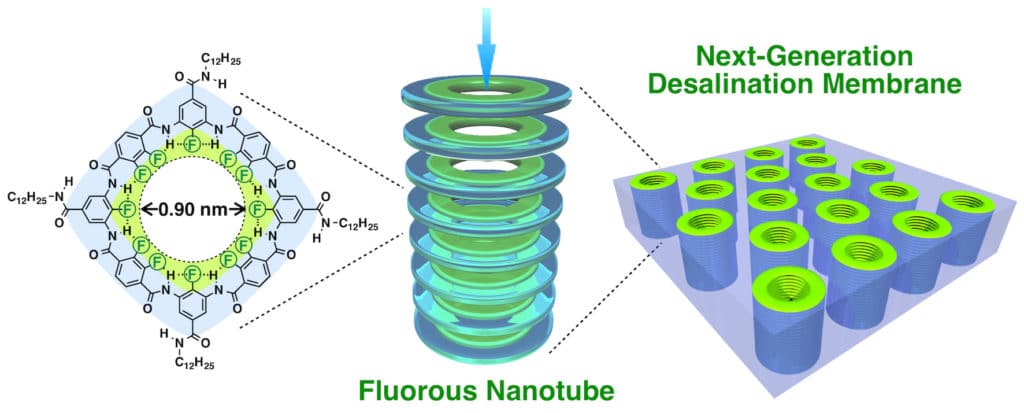Clean water scarcity is a major issue in today’s world, and the problem is only going to worsen with a changing climate. Desalinating brackish water or seawater is an established method to produce drinkable water, but it comes with huge energy costs. There’s no shortage of creative devices in the works, either using heat to evaporate and recondense water or membranes to filter salt and impurities out.
Now, the University of Tokyo engineers have developed a fluorine-based desalination membrane to successfully filter salt from water. They claim the method is faster, more effective, and requires less pressure and less energy compared to current desalination methods.
The new membrane is made up of a series of nanoscale tubes lined with a Teflon-inspired material that repels salts and also improves the flow of water with little friction. The key component of Teflon is fluorine, a natural water-repelling or hydrophobic material that gives Teflon its famous non-stick properties. The fluorine-based coatings are often used for pipes to keep water flowing smoothly.
“We were curious to see how effective a fluorous nanochannel might be at selectively filtering different compounds, particularly water and salt. And, after running some complex computer simulations, we decided it was worth the time and effort to create a working sample,” said Associate Professor Yoshimitsu Itoh at the University of Tokyo. “There are two main ways to desalinate water currently: thermally, using heat to evaporate seawater, so it condenses as pure water, or by reverse osmosis, which uses pressure to force water through a membrane that blocks salt. Both methods require a lot of energy, but our tests suggest fluorous nanochannels require little energy and have other benefits too.”

The new filtration membranes contain chemically synthesizing nanoscopic fluorine rings, which are stacked and embedded in an otherwise impermeable lipid layer, similar to the organic molecules that make up cell walls. The team created several test samples with nanorings between about 1 and 2 nanometers wide and then flowed saltwater through them.
To test the effectiveness of their membranes, Itoh and the team measured the presence of chlorine ions, one of the major components of salt – the other being sodium – on either side of the test membrane. Fluorine is electrically negative; it repels negative ions, such as the chlorine found in salt. The team’s fluorine-based water desalination membranes are more effective, faster, require less energy to operate, and are made to be very simple to use as well.
“It was very exciting to see the results first-hand. The smaller of our test channels perfectly rejected incoming salt molecules, and the larger channels too were still an improvement over other desalination techniques and even cutting-edge carbon nanotube filters,” said Itoh. “The real surprise to me was how fast the process occurred. Our sample worked around several thousand times faster than typical industrial devices, and around 2,400 times faster than experimental carbon nanotube-based desalination devices.”
At present, synthesizing the materials is relatively energy-intensive, which researchers hope to improve in upcoming research. And, given the longevity of the membranes and their low operational costs, the overall energy costs will be much lower than with current methods, they say. In addition, the team hopes to create a membrane around 1 meter across in several years.
